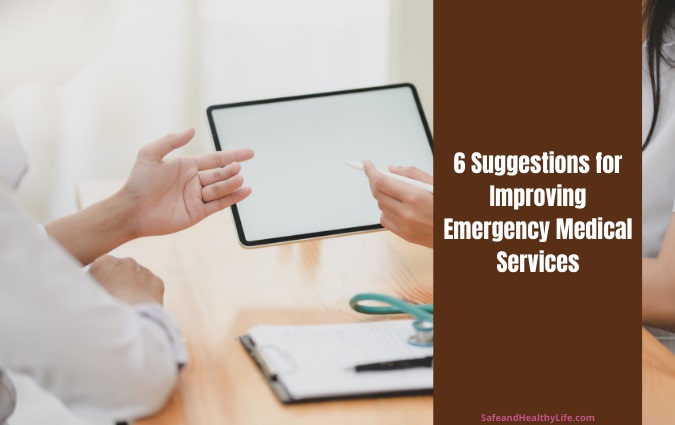
Medical emergencies can happen anytime, anywhere. As such, it is imperative that hospitals and other medical facilities that receive emergency calls are adequately prepared for all kinds of emergencies to ensure that timely and appropriate medical care can be given to people who need it, and as an ultimate goal, to reduce mortality rates.
The term “emergency medical services” or EMS, refers to the total system intended to care for a casualty, from the site of the incident to definitive care. It may be regional, community, or institution-based, which provides for utilization of available personnel, equipment, transportation, and communication to ensure effective and coordinated delivery of medical care in emergency situations.
EMS encompasses a wide range of activities that constitute prehospital care, such as 911 dispatch, treatment and triage, and non-emergency transport to a care facility.
For an EMS to be effective, it must be able to carry out all six phases of an EMS response: detection, response, reporting, on-site care, care during transit, and transfer to definitive care.
Listed below are a few suggestions on how to improve the overall quality of emergency medical services.
1. Use Computer-Aided Dispatch Systems
The cornerstone of any EMS is a quick and efficient emergency response. Studies have consistently shown that reduced response times lead to higher survival rates and decreased mortality among patients.
EMS organizations should use EMS dispatch software to efficiently deploy emergency responders and improve resource utilization during an emergency situation.
These systems allow an EMS or a medical facility to manage schedules easily by identifying available time slots, thereby ensuring that an emergency response team will be available at any given time.
2. Ensure Adequate Manpower
A successful emergency response relies on the formation of a reliable response team. Depending on the magnitude and complexity of the incident, the number of crew members to be deployed will vary.
It is crucial that each of them is tasked with a specific assignment to ensure that no response action will be missed.
A crew scheduler that’s integrated with the dispatch software can be a useful tool to guarantee that vehicles and crew are staffed round-the-clock.
3. Ensure Adequate Supply of Essentials
Equally as important as having sufficient responders on-scene is making sure that there is always an adequate supply of medical essentials, which include basic supplies such as bandages and antiseptic solutions, and an assortment of emergency medications like antihistamines, nitroglycerin, and salbutamol.
In most emergency cases, timely administration of these medications positively impacts the survival of patients. Sometimes, these medications draw the line between life and death.
4. Compliance and Certification
An effective emergency response team consists of highly skilled individuals who have been trained to provide emergency care. These individuals must have knowledge of basic first-aid skills such as airway and ventilation, CPR, spine immobilization, and even emergency childbirth. It is critical for any emergency response team to undergo rigorous and continuous skills training and workshops so that they get certified.
EMS organizations should also ensure that they receive the latest training so their certifications are up to date. This will equip them with the right knowledge and ability to perform these tasks whenever and wherever needed.
A good EMS software should have the capability to notify management when certifications of crew members are about to expire so they can ensure compliance.
5. Develop an Efficient Emergency Response Process
Because most emergencies are time-sensitive, a coordinated system is essential to ensure that care will be delivered in a timely manner.
Trauma patients and those inflicted with a sudden serious disease must be able to get the right care at the right time. For this to happen, an emergency response process must be in place.
As soon as an emergency call is made, staff will only need to follow the emergency response to dispatch medical personnel, coordinate with different departments, and prepare the necessary resources.
6. Performance Evaluation
Evaluation of an emergency response is crucial to determine its effectiveness and efficacy. One simple way to evaluate the performance of your emergency response team is by collecting data.
Average response times, number of medical personnel on board, and time spent per dispatch are some useful parameters to determine how good your emergency response is.
These data can also be used to establish performance standards and identify areas for improvement.
It is especially helpful when you have all these data in one place, such as an all-in-one EMS management software. That way, you wouldn’t have to integrate multiple EMS software together, or having to pull data from multiple EMS software to generate the necessary reports to evaluate performance.
Conclusion
EMS plays a vital role in the delivery of emergency care. They are on the front lines of emergency care. Improvements in this area will increase survival rates among patients when adequate and appropriate emergency services can be performed to the right people, at the right place, and at the right time.
About The Author:
“Angelica “Anj” De Jesus,23, is a content writer, a mom, and a marketing professional based in Manila, Philippines. She spends a lot of time studying how technology continues to transform lifestyles, fashion, businesses, and communities. Outside the office, she keeps herself busy by staying up-to-date with the latest fashion trends, reading about the newest gadgets out on the market, and of course spending time discovering different parenting skills that are best for her little boy.




